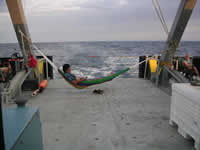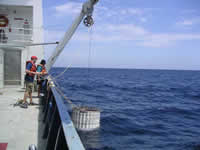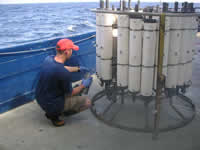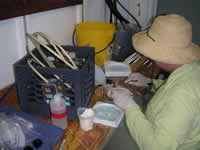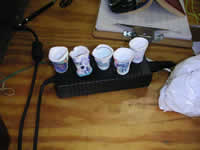


|
The Project Part 1: Part 2: Part 3:
|
27 July, 2005Today we continue our voyage up the Gulf in blinding sun and intense heat. The sea surface temperature hit 30° before noon! Soon we will come to our first sampling station where Gregg will lower the CTD 2000 meters below the surface at the site of a hot vent on the ocean floor. He studies how bacteria precipitate metals, in particular manganese oxide, from seawater (similar to the oxidation of iron which creates rust). Precipitation means the process of separating some substance from a solution or liquid. Can you convert meters to feet? How far down in feet will the CTD go? We know the location of the vent because a submersible located it in the 1980s. Hot vents are located where two tectonic plates of the Earth’s crust meet. Hot gases and particulates seep out from deep within the Earth’s interior. It took the winch 42 minutes to lower the CTD to a depth of 2000 meters. How fast in meters (and feet) was the CTD sinking into the ocean? Gregg has some questions to ask of these bacteria:
More from The Log from the Sea of Cortez “One thing has impressed us deeply on this little voyage: the great world dropped away very quickly. We lost the fear and contagion of war and economic uncertainty. The matters of great importance we left behind were not important. There must be an ineffective quality in these things. We had lost the virus, or it had been eaten by the anti-bodies of quiet.” Steinbeck’s expedition to the Gulf of California took place a year and a half before the USA entered WWII, but Europe was already embroiled in bitter conflict and Americans still struggled from the effects of the Great Depression. Sixty years later, the US faces war and uncertainties of a different nature. At sea, we are away from the TVs, newspapers, radios and telephones that cause these issues to occupy our thoughts when we are on land. We receive short news blurbs on our email everyday from a news service that caters to people at sea. But the great issues that worry us when we ashore have faded away, and all thought and effort is put into successfully conducting the experiments that are the purpose of our voyage. All this planning and effort, however, is not without a little rest and relaxation. Rob sways in the hammock with a book after the workday is done. And we can even have a little fun, too, crushing Styrofoam cups by sending them down with the CTD. All that pressure has shrunk them, but they retain their shape. Trivia Tidbit of the Day: The word “hammock” comes to us from the native peoples who lived on islands in the Caribbean Sea. The Spanish first encountered the Taino and their sleeping arrangements back in the 15th century. The Spanish called these swinging beds “hammoca,” taking their cue from the original Taino word.
|

